Impacts of Intraseasonal Oscillations on Tropical Cyclone Rapid Intensification in the Northwestern Pacific During Winter
Abstract
1. Introduction
2. Materials and Methods
2.1. Data
2.2. Definition of TC and TCRI
2.3. Classification of MJO and QBWO Phases
3. Results
3.1. Statistical Analysis of RITCs
3.2. Impacts of MJO on TCRI
3.3. Impacts of QBWO on TCRI
3.4. Combined Impacts of MJO and QBWO on TCRI
4. Discussion and Conclusions
Author Contributions
Funding
Data Availability Statement
Conflicts of Interest
References
- Gemmer, M.; Yin, Y.; Luo, Y.; Fischer, T. Tropical cyclones in China: County-based analysis of landfalls and economic losses in Fujian Province. Quat. Int. 2011, 244, 169–177. [Google Scholar] [CrossRef]
- Peduzzi, P.; Chatenoux, B.; Dao, H.; De Bono, A.; Herold, C.; Kossin, J.; Mouton, F.; Nordbeck, O. Global Trends in Tropical Cyclone Risk. Nat. Clim. Change 2012, 2, 289–294. [Google Scholar] [CrossRef]
- Zhang, Q.; Wu, L.; Liu, Q. Tropical cyclone damages in China 1983–2006. Bull. Am. Meteorol. Soc. 2009, 90, 489–496. [Google Scholar] [CrossRef]
- Hendricks, E.A.; Peng, M.S.; Fu, B.; Li, T. Quantifying Environmental Control on Tropical Cyclone Intensity Change. Mon. Weather Rev. 2010, 138, 3243–3271. [Google Scholar] [CrossRef]
- Lee, C.Y.; Tippett, M.K.; Sobel, A.H.; Camargo, S.J. Rapid Intensification and the Bimodal Distribution of Tropical Cyclone Intensity. Nat. Commun. 2016, 7, 10625. [Google Scholar] [CrossRef]
- Knaff, J.A.; Sampson, C.R.; Musgrave, K.D. An Operational Rapid Intensification Prediction Aid for the Western North Pacific. Weather Forecast. 2018, 33, 799–811. [Google Scholar]
- Elsberry, R.L.; Lambert, T.D.; Boothe, M.A. Accuracy of Atlantic and Eastern North Pacific Tropical Cyclone Intensity Forecast Guidance. Weather Forecast. 2007, 22, 747–762. [Google Scholar] [CrossRef]
- Elsberry, R.L. Advances in Research and Forecasting of Tropical Cyclones from 1963–2013. Asia-Pac. J. Atmos. Sci. 2014, 50, 3–16. [Google Scholar] [CrossRef]
- McBride, J.L. Tropical Cyclone Formation. In Global Perspective on Tropical Cyclones; Elsberry, R.L., Ed.; WMO: Geneva, Switzerland, 1995; pp. 63–105. [Google Scholar]
- Gray, W.M. Global View of the Origin of Tropical Disturbances and Storms. Mon. Weather Rev. 1968, 96, 669–700. [Google Scholar] [CrossRef]
- Wu, L.; Wen, Z.; Huang, R.; Wu, R. Possible Linkage Between the Monsoon Trough Variability and the Tropical Cyclone Activity over the Western North Pacific. Mon. Weather Rev. 2012, 140, 140–150. [Google Scholar] [CrossRef]
- Weng, J.; Wang, L.; Luo, J.; Chen, B.; Peng, X.; Gan, Q. A Contrast of the Monsoon–Tropical Cyclone Relationship Between the Western and Eastern North Pacific. Atmosphere 2022, 13, 1465. [Google Scholar] [CrossRef]
- Emanuel, K.A. Thermodynamic Control of Hurricane Intensity. Nature 1999, 401, 665–669. [Google Scholar]
- Chan, J.C.; Duan, Y.; Shay, L.K. Tropical Cyclone Intensity Change from a Simple Ocean–Atmosphere Coupled Model. J. Atmos. Sci. 2001, 58, 154–172. [Google Scholar]
- Wu, L.; Wang, B. Assessing Impacts of Global Warming on Tropical Cyclone Tracks. J. Clim. 2004, 17, 1686–1698. [Google Scholar]
- Hong, J.; Wu, Q. Modulation of Global Sea Surface Temperature on Tropical Cyclone Rapid Intensification Frequency. Environ. Res. Commun. 2021, 3, 041001. [Google Scholar]
- Emanuel, K.; DesAutels, C.; Holloway, C.; Korty, R. Environmental Control of Tropical Cyclone Intensity. J. Atmos. Sci. 2004, 61, 843–858. [Google Scholar]
- Lin, I.I.; Liu, W.T.; Wu, C.C.; Chiang, J.C.H.; Sui, C.H. Satellite Observations of Modulation of Surface Winds by Typhoon-Induced Upper Ocean Cooling. Geophys. Res. Lett. 2003, 30, 1131. [Google Scholar]
- Lin, I.I.; Wu, C.C.; Emanuel, K.A.; Lee, I.H.; Wu, C.R.; Pun, I.F. The Interaction of Supertyphoon Maemi (2003) with a Warm Ocean Eddy. Mon. Weather Rev. 2005, 133, 2635–2649. [Google Scholar] [CrossRef]
- Wu, C.C.; Lee, C.Y.; Lin, I.I. The Effect of the Ocean Eddy on Tropical Cyclone Intensity. J. Atmos. Sci. 2007, 64, 3562–3578. [Google Scholar]
- Molinari, J.; Vollaro, D. What Percentage of Western North Pacific Tropical Cyclones Form within the Monsoon Trough? Mon. Weather Rev. 2013, 141, 499–505. [Google Scholar]
- Chen, T.; Chen, S.; Zhou, M.; Tu, C.; Zhang, A.; Chen, Y.; Li, W. Northward Shift in Landfall Locations of Tropical Cyclones over the Western North Pacific during the Last Four Decades. Adv. Atmos. Sci. 2022, 39, 304–319. [Google Scholar] [CrossRef]
- Liu, K.S.; Chan, J.C. Recent Increase in Extreme Intensity of Tropical Cyclones Making Landfall in South China. Clim. Dyn. 2020, 55, 1059–1074. [Google Scholar] [CrossRef]
- Zhao, H.; Wang, C.; Yoshida, R. Modulation of Tropical Cyclogenesis in the Western North Pacific by the Quasi-Biweekly Oscillation. Adv. Atmos. Sci. 2016, 33, 1361–1375. [Google Scholar] [CrossRef]
- Guo, Y.P.; Tan, Z.M. Westward Migration of Tropical Cyclone Rapid-Intensification over the Northwestern Pacific during Short Duration El Niño. Nat. Commun. 2018, 9, 1507. [Google Scholar] [CrossRef] [PubMed]
- Lee, M.; Kim, T.; Cha, D.H.; Min, S.K.; Park, D.S.R.; Yeh, S.W.; Chan, J.C. How Does Pacific Decadal Oscillation Affect Tropical Cyclone Activity over Far East Asia? Geophys. Res. Lett. 2021, 48, e2021GL096267. [Google Scholar] [CrossRef]
- Yoshida, R.; Kajikawa, Y.; Ishikawa, H. Impact of Boreal Summer Intraseasonal Oscillation on Environment of Tropical Cyclone Genesis over the Western North Pacific. Sola 2014, 10, 15–18. [Google Scholar] [CrossRef]
- Basconcillo, J.; Moon, I.J. Increasing Activity of Tropical Cyclones in East Asia during the Mature Boreal Autumn Linked to Long-Term Climate Variability. Npj Clim. Atmos. Sci. 2022, 5, 4. [Google Scholar] [CrossRef]
- Camargo, S.J.; Sobel, A.H. Western North Pacific Tropical Cyclone Intensity and ENSO. J. Clim. 2005, 18, 2996–3006. [Google Scholar] [CrossRef]
- Gao, J.; Zhao, H.; Klotzbach, P.J.; Shi, C.; Ma, Z. Recent Weakening of the Relationship between El Niño–Southern Oscillation and Western North Pacific Tropical Cyclone Season Onset Date. Int. J. Climatol. 2022, 42, 9462–9470. [Google Scholar] [CrossRef]
- Wu, L.; Takahashi, M. Contributions of Tropical Waves to Tropical Cyclone Genesis over the Western North Pacific. Clim. Dyn. 2018, 50, 4635–4649. [Google Scholar] [CrossRef]
- Latos, B.; Peyrillé, P.; Lefort, T.; Baranowski, D.B.; Flatau, M.K.; Flatau, P.J.; Matthews, A.J. The Role of Tropical Waves in the Genesis of Tropical Cyclone Seroja in the Maritime Continent. Nat. Commun. 2023, 14, 856. [Google Scholar] [CrossRef]
- Li, R.C.; Zhou, W. Modulation of Western North Pacific Tropical Cyclone Activity by the ISO. Part II: Tracks and Landfalls. J. Clim. 2013, 26, 2919–2930. [Google Scholar] [CrossRef]
- Hsu, P.C.; Li, T. Interactions Between Boreal Summer Intraseasonal Oscillations and Synoptic-Scale Disturbances over the Western North Pacific. Part II: Apparent Heat and Moisture Sources and Eddy Momentum Transport. J. Clim. 2011, 24, 942–961. [Google Scholar]
- Maloney, E.D.; Dickinson, M.J. The Intraseasonal Oscillation and the Energetics of Summertime Tropical Western North Pacific Synoptic-Scale Disturbances. J. Atmos. Sci. 2003, 60, 2153–2168. [Google Scholar] [CrossRef]
- Madden, R.A.; Julian, P.R. Description of Global-Scale Circulation Cells in the Tropics with a 40–50 Day Period. J. Atmos. Sci. 1972, 29, 1109–1123. [Google Scholar]
- Klotzbach, P.J. The Madden–Julian Oscillation’s Impacts on Worldwide Tropical Cyclone Activity. J. Clim. 2014, 27, 2317–2330. [Google Scholar] [CrossRef]
- Jia, X.; Yang, S. Impact of the Quasi-Biweekly Oscillation over the Western North Pacific on East Asian Subtropical Monsoon during Early Summer. J. Geophys. Res. Atmos. 2013, 118, 4421–4434. [Google Scholar]
- Ling, Z.; Wang, Y.; Wang, G. Impact of Intraseasonal Oscillations on the Activity of Tropical Cyclones in Summer over the South China Sea. Part I: Local Tropical Cyclones. J. Clim. 2016, 29, 855–868. [Google Scholar]
- Shu, S.; Ming, J.; Chi, P. Large-Scale Characteristics and Probability of Rapidly Intensifying Tropical Cyclones in the Western North Pacific Basin. Weather Forecast. 2012, 27, 411–423. [Google Scholar]
- Webster, P.J.; Holland, G.J.; Curry, J.A.; Chang, H.R. Changes in Tropical Cyclone Number, Duration, and Intensity in a Warming Environment. Science 2005, 309, 1844–1846. [Google Scholar]
- Bhatia, K.; Baker, A.; Yang, W.; Vecchi, G.; Knutson, T.; Murakami, H.; Whitlock, C. A Potential Explanation for the Global Increase in Tropical Cyclone Rapid Intensification. Nat. Commun. 2022, 13, 6626. [Google Scholar] [CrossRef]
- Zhao, H.; Duan, X.; Raga, G.B.; Klotzbach, P.J. Changes in Characteristics of Rapidly Intensifying Western North Pacific Tropical Cyclones Related to Climate Regime Shifts. J. Clim. 2018, 31, 8163–8179. [Google Scholar] [CrossRef]
- Wang, B.; Zhou, X. Climate Variation and Prediction of Rapid Intensification in Tropical Cyclones in the Western North Pacific. Meteorol. Atmos. Phys. 2008, 99, 1–16. [Google Scholar] [CrossRef]
- Fudeyasu, H.; Ito, K.; Miyamoto, Y. Characteristics of Tropical Cyclone Rapid Intensification over the Western North Pacific. J. Clim. 2018, 31, 8917–8930. [Google Scholar] [CrossRef]
- Ge, X.; Shi, D.; Guan, L. Monthly Variations of Tropical Cyclone Rapid Intensification Ratio in the Western North Pacific. Atmos. Sci. Lett. 2018, 19, e814. [Google Scholar] [CrossRef]
- Aberson, S.D.; Kaplan, J. The Relationship between the Madden–Julian Oscillation and Tropical Cyclone Rapid Intensification. Weather Forecast. 2020, 35, 1865–1870. [Google Scholar] [CrossRef]
- Matthews, A.J. Propagation Mechanisms for the Madden-Julian Oscillation. Q. J. R. Meteorol. Soc. 2000, 126, 2637–2651. [Google Scholar]
- Li, R.C.; Zhou, W.; Chan, J.C.; Huang, P. Asymmetric Modulation of Western North Pacific Cyclogenesis by the Madden–Julian Oscillation under ENSO Conditions. J. Clim. 2012, 25, 5374–5385. [Google Scholar] [CrossRef]
- Zhao, H.; Jiang, X.; Wu, L. Modulation of Northwest Pacific Tropical Cyclone Genesis by the Intraseasonal Variability. J. Meteorol. Soc. Jpn. Ser. II 2015, 93, 81–97. [Google Scholar] [CrossRef]
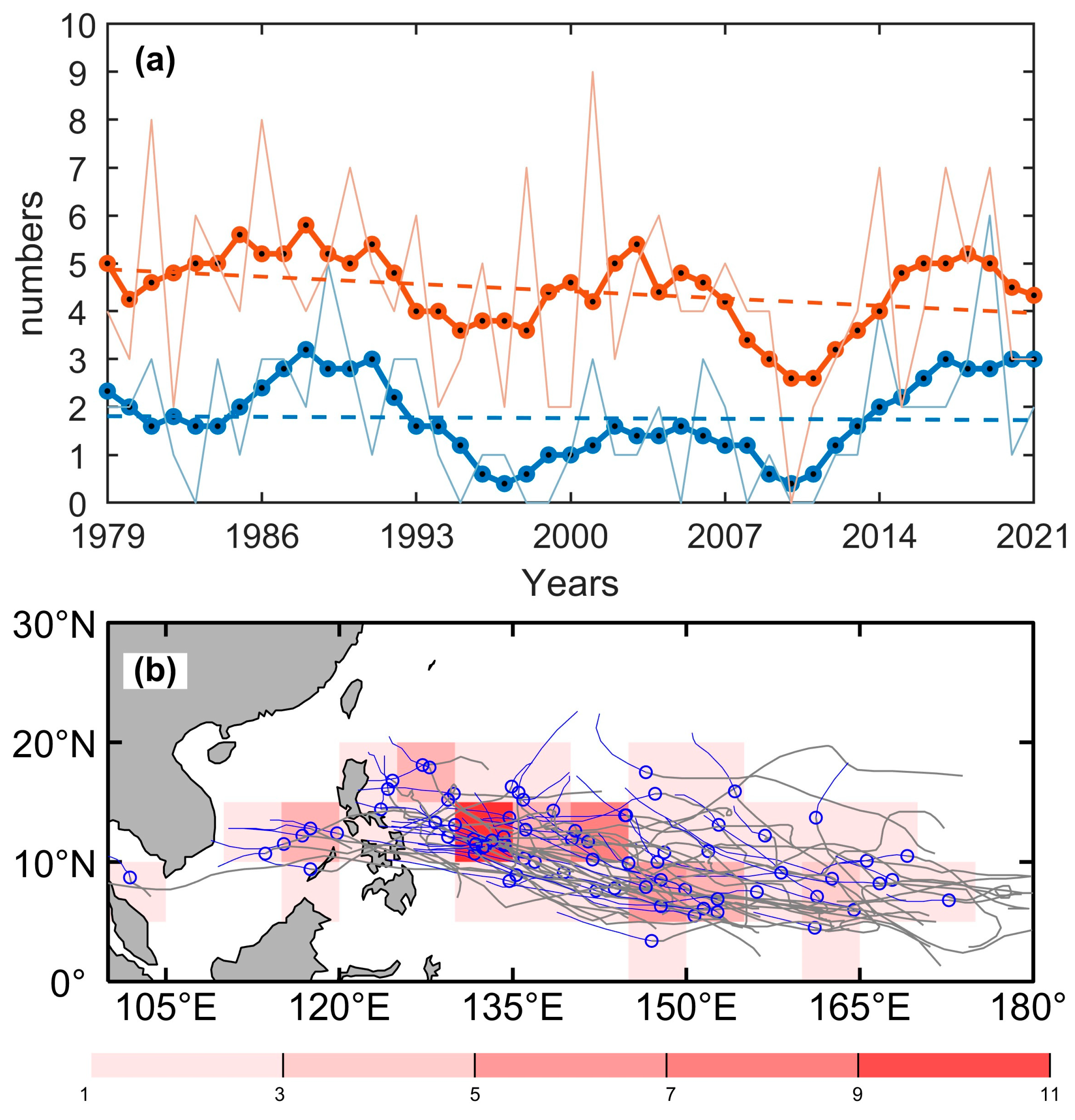


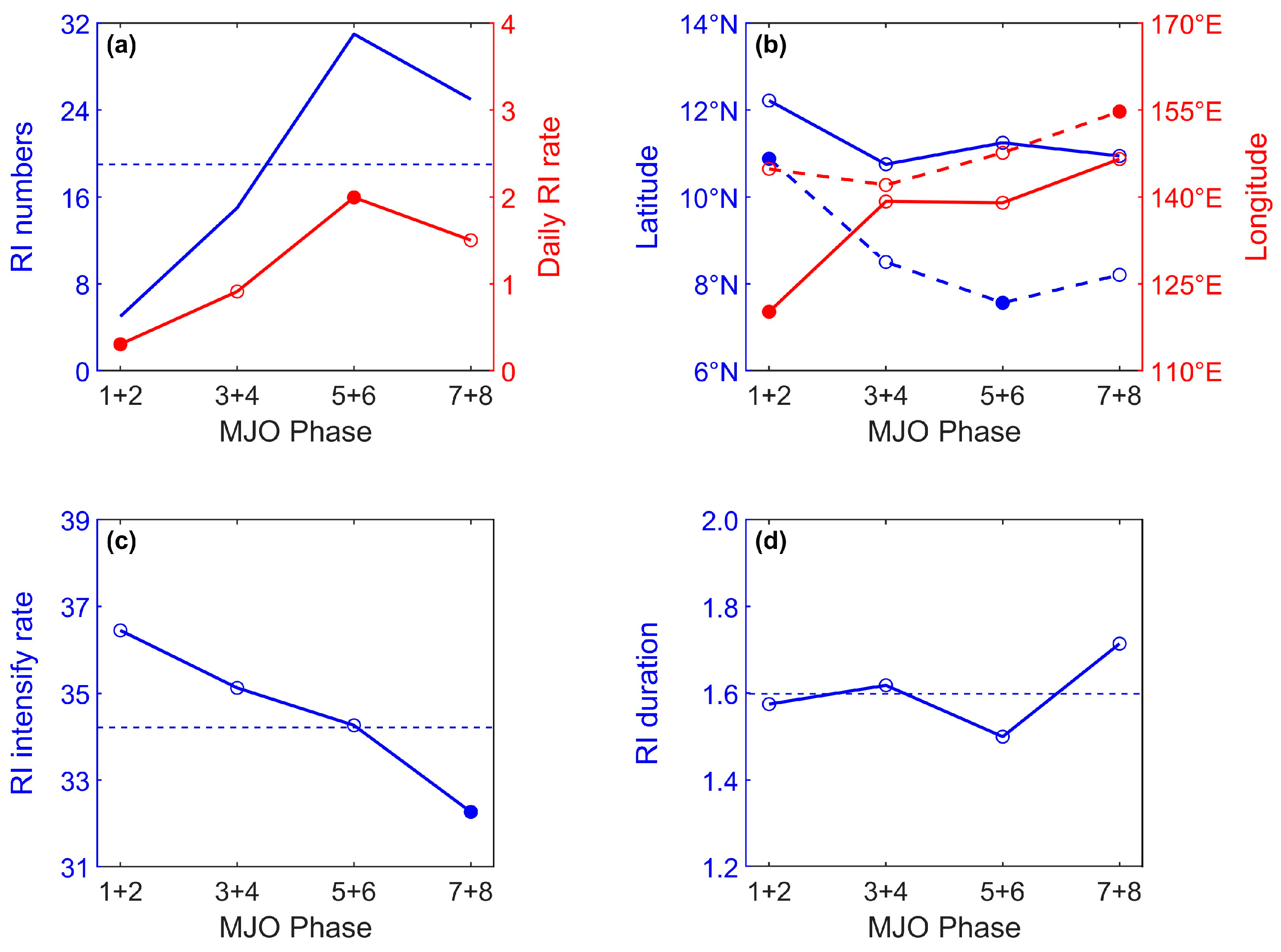
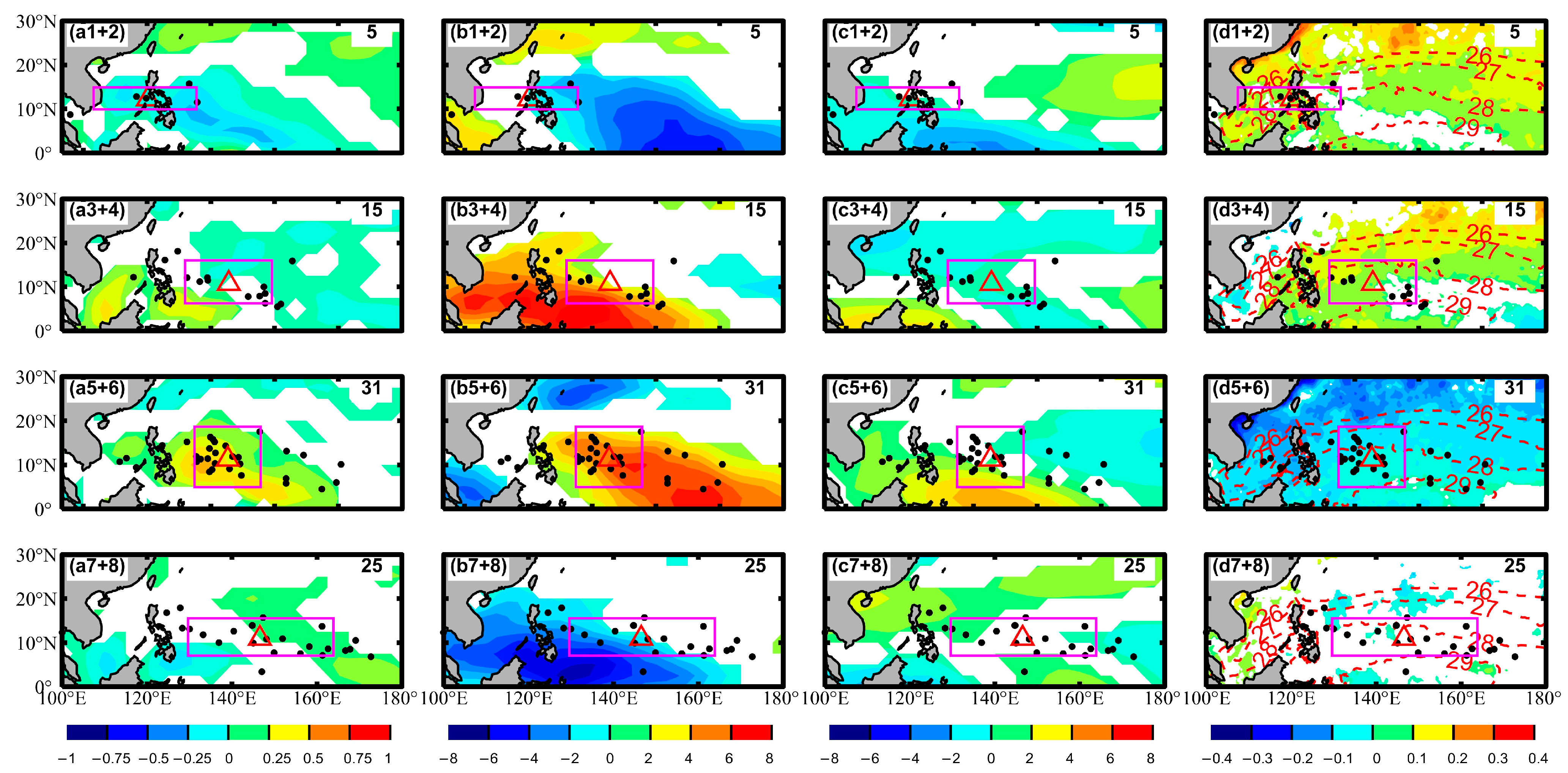

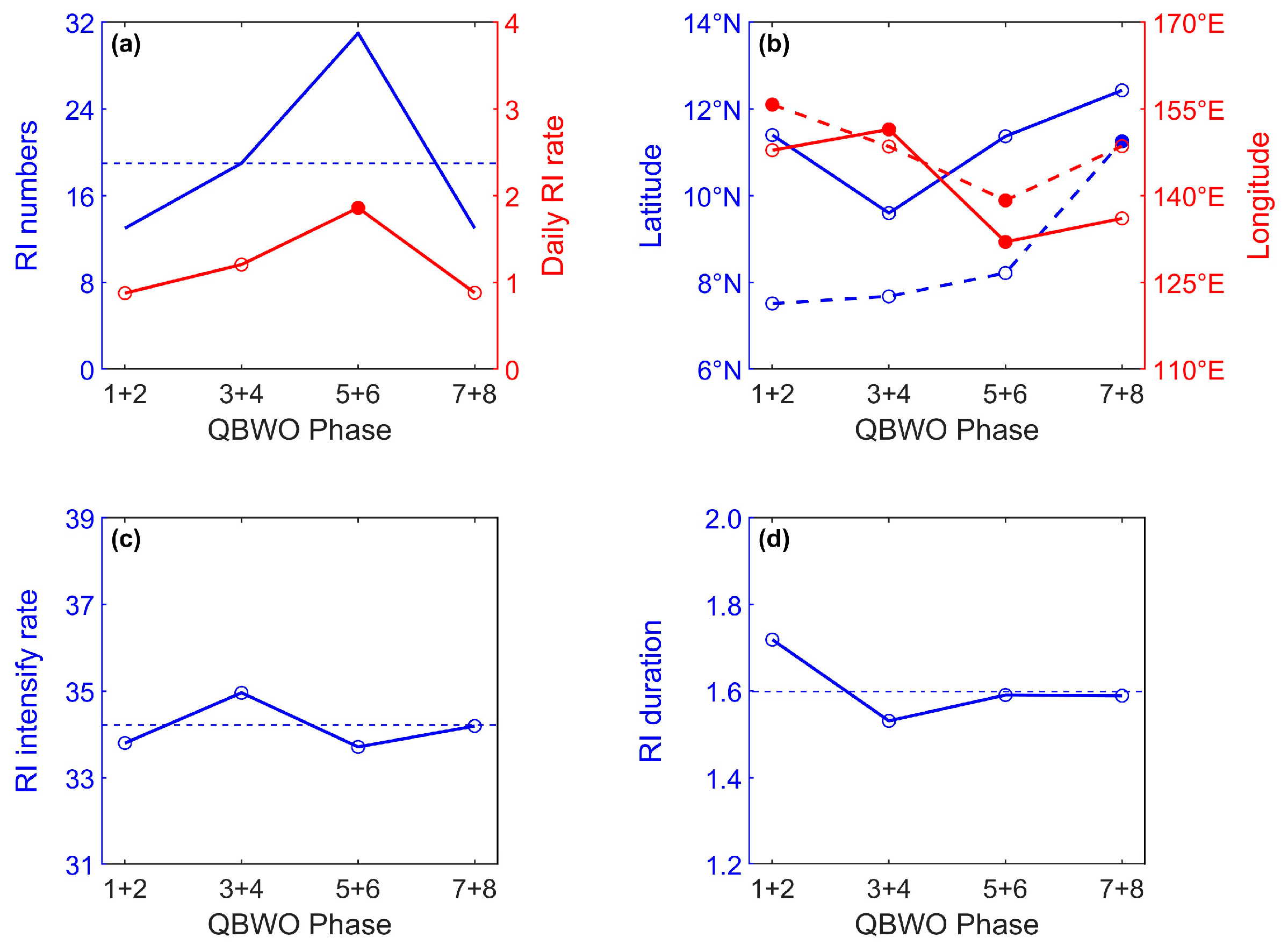

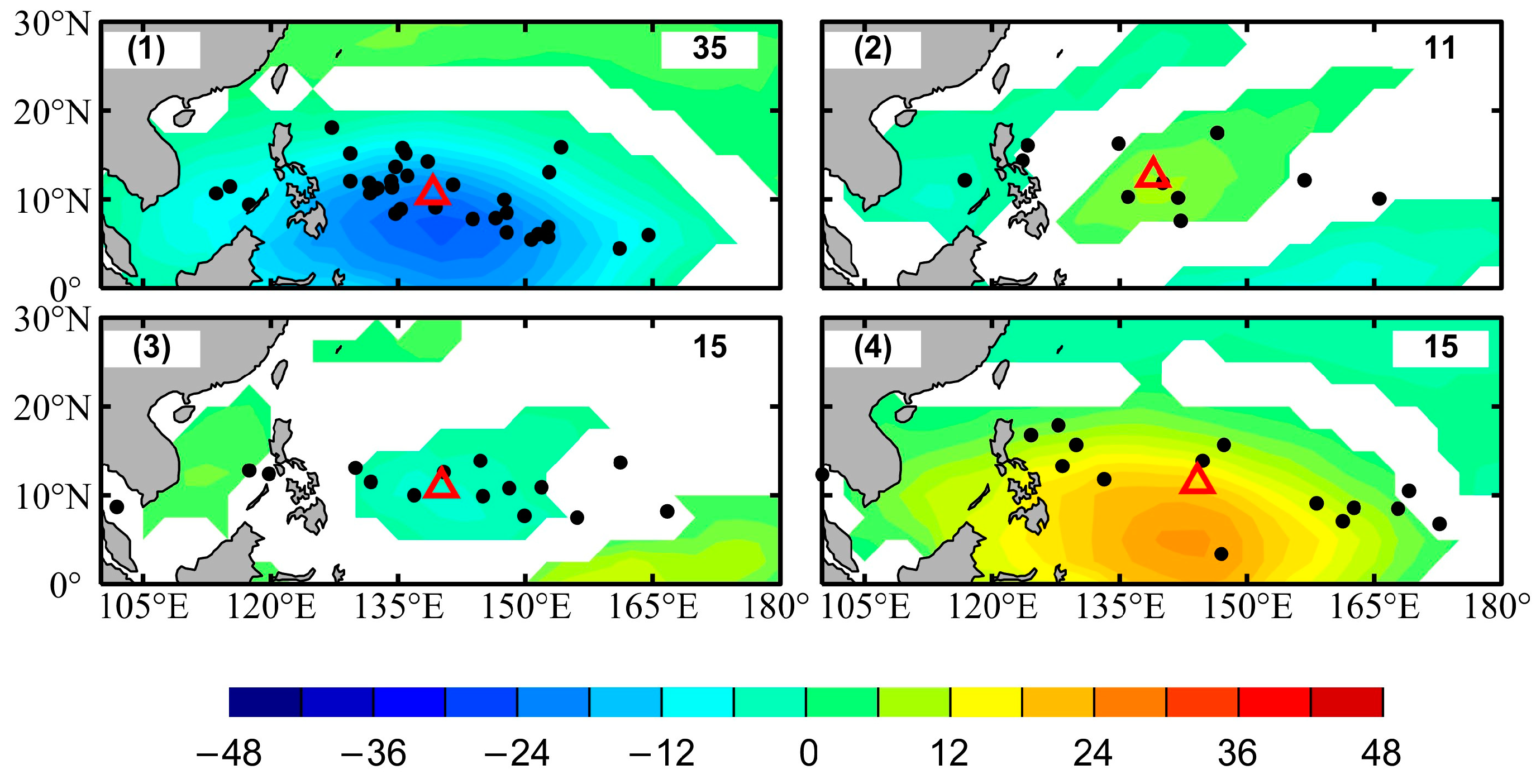


Disclaimer/Publisher’s Note: The statements, opinions and data contained in all publications are solely those of the individual author(s) and contributor(s) and not of MDPI and/or the editor(s). MDPI and/or the editor(s) disclaim responsibility for any injury to people or property resulting from any ideas, methods, instructions or products referred to in the content. |
© 2025 by the authors. Licensee MDPI, Basel, Switzerland. This article is an open access article distributed under the terms and conditions of the Creative Commons Attribution (CC BY) license (https://creativecommons.org/licenses/by/4.0/).
Share and Cite
Chen, C.; Ling, Z.; He, H.; Zhang, T. Impacts of Intraseasonal Oscillations on Tropical Cyclone Rapid Intensification in the Northwestern Pacific During Winter. Remote Sens. 2025, 17, 1259. https://doi.org/10.3390/rs17071259
Chen C, Ling Z, He H, Zhang T. Impacts of Intraseasonal Oscillations on Tropical Cyclone Rapid Intensification in the Northwestern Pacific During Winter. Remote Sensing. 2025; 17(7):1259. https://doi.org/10.3390/rs17071259
Chicago/Turabian StyleChen, Chaodong, Zheng Ling, Hailun He, and Tianyu Zhang. 2025. "Impacts of Intraseasonal Oscillations on Tropical Cyclone Rapid Intensification in the Northwestern Pacific During Winter" Remote Sensing 17, no. 7: 1259. https://doi.org/10.3390/rs17071259
APA StyleChen, C., Ling, Z., He, H., & Zhang, T. (2025). Impacts of Intraseasonal Oscillations on Tropical Cyclone Rapid Intensification in the Northwestern Pacific During Winter. Remote Sensing, 17(7), 1259. https://doi.org/10.3390/rs17071259







